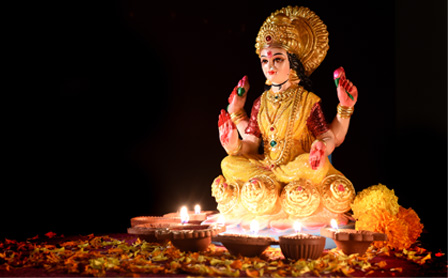Varalakshmi Vratham is a celebration for married Hindu women who pray for the welfare of their husbands and families by observing a fast in honor of Goddess Lakshmi, the wife of Lord Vishnu. This festival is celebrated in Tamilnadu, Karnataka, Telangana, and Andhra Pradesh. It is held in the month of Sravana or Sawan (July-August) on the first Friday or second Friday of full moon day or Poornima.
The History of Varalakshmi Vrata
Once, there was a pious Brahmin woman called Charumathi. She lived with her husband in a town called Kundina in the Magadha Kingdom. One day she had a dream in which Goddess Mahalakshmi appeared and asked her to perform a Pooja on the full moon day of Shravana month. The goddess also asked her to perform Varalakshmi Vrata as it would help fulfill all her wishes. The next day, Charumathi described the dream she had the previous night to her family members. They took it seriously, and a Pooja was conducted as instructed by Lakshmi Charumati also invited all the women of her village to join her, and thus, the Pooja became like a festival, with the women offering new dresses and sweets to the goddess. They also observed the vratam with utmost devotion and faith.
Varalakshmi Vratam CelebrationsThe festival is celebrated in the month of Shravana on the second Friday that falls on Poornima. Women wake up early in the morning and take a bath in Brahmamurtham. Then they clean and decorate the Pooja area with rangoli or kolam. They also prepare kalash using a silver or bronze pot. The Swastik symbol is drawn in the Pooja area and sandalwood paste is smeared. They fill the kalash with five different kinds of leaves, coins, water, raw rice and betel nut. A mirror, turmeric, black beads, small black bangles, and comb are some of the other items that are included.
The neck of the kalash is covered with a piece of cloth and mango leaves are placed in its mouth. The mouth of the kalash is closed with a coconut smeared in turmeric. It is kept in front of Goddess Lakshmi’s idol, and Aarti is performed. The kalash is placed on a bed of rice. During this ritual, it is assumed that the family members are blessed by Lakshmi. The Pooja begins with the worship of Lord Ganesha, followed by Lakshmi Pooja. Sweets are distributed among the participants, and new clothes are worn for the occasion. On Saturday, the water in the kalash is sprinkled in the house.
Significance of the festival
There are eight energies or forces – Bhu (Earth), Siri (Wealth), Sarasvathi (learning), Keerthi (Fame), Shanthi (Peace), Prithi (Love), Pushti(Strength) and Santhushti(Pleasure).These are the Ashta Lakshmis that bring wealth, happiness, and prosperity to our lives. By performing Varalakshmi Vratam, we make it possible for these eight energies to enter our life.
Mythology behind Varalakshmi Vratam
The Skanda Purana says that Goddess Parvati once asked Lord Shiva, her consort, if there was any vrata that was beneficial to women. Shiva responded that the Varalakshmi Vrata was good for married women, and narrated the story of Charumati and Varalakshmi Vratham.
Another myth has to do with Shyamabala, the daughter of King Bathrasiravas and Queen Surachandrika. Her husband was a prince.
Once when Shyamabala was at her parents’ palace, she witnessed her mother, Queen Surachandrika, scolding and chasing away an old lady. The old woman was telling the Queen to perform Varalakshmi Pooja, but the queen was in no mood to take advice from a beggar and drove her away.
But Shyamabala called the old lady and listened to her advice. After returning to her husband’s kingdom, she performed the Vrata dutifully. Soon her husband’s kingdom became prosperous.
Meanwhile, Shyamabala’s parents faced many problems. They lost all their wealth and people became unhappy with them. On hearing reports about their problems, Shyamabala sent them some pots of gold, but when Queen Surachandrika’s gaze fell on them, they turned to ashes. Shyamabala realized that all the problems were related to her mother’s treatment of the old woman. She also understood that the old woman was Goddess Lakshmi in disguise. By chasing away the old woman who was actually Mahalakshmi, the queen had driven away prosperity and good fortune from her kingdom.
By doing Varalakshmi Vratam every year, women can ensure the welfare of their husbands and families, thanks to the grace of Goddess Lakshmi.






